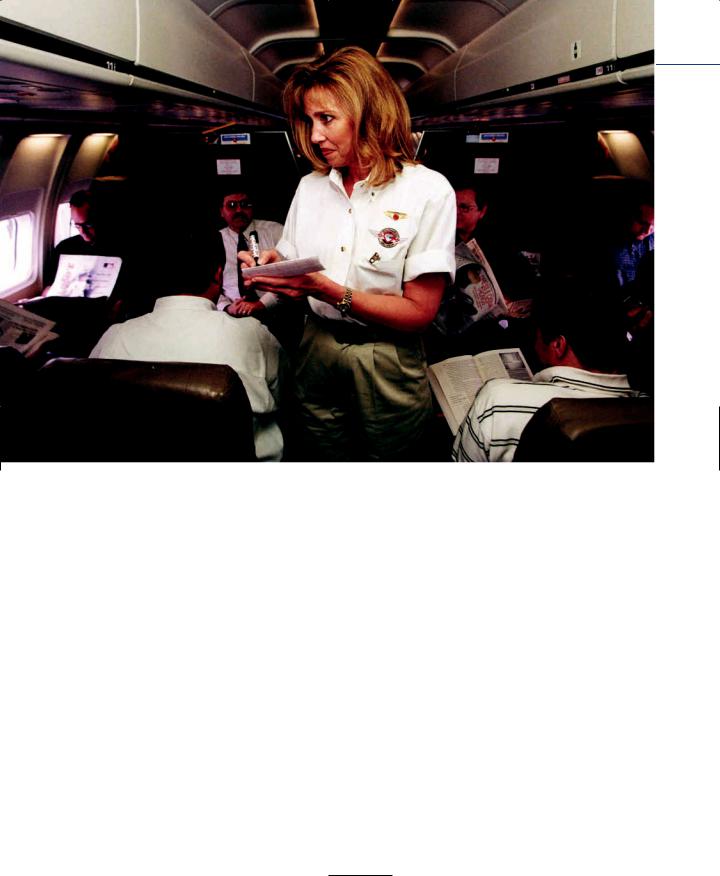
- •CONTENTS
- •PREFACE
- •Content—Benefits for Students
- •Content—Benefits for Instructors
- •Features of the Book for Students and Instructors
- •Supplementary Materials
- •Acknowledgments
- •What Is Hospitality Management?
- •The Manager’s Role in the Hospitality Industry
- •Why Study in a Hospitality Management Program?
- •Planning a Career
- •Employment as an Important Part of Your Education
- •Getting a Job
- •Employment at Graduation
- •The Outlook for Hospitality
- •Summary
- •Managing Change
- •Demand
- •Supply
- •Workforce Diversity
- •The Impact of Labor Scarcity
- •Summary
- •The Varied Field of Food Service
- •The Restaurant Business
- •The Dining Market and the Eating Market
- •Contemporary Popular-Priced Restaurants
- •Restaurants as Part of a Larger Business
- •Summary
- •Restaurant Operations
- •Making a Profit in Food Service Operations
- •Life in the Restaurant Business
- •Summary
- •Chain Restaurant Systems
- •Independent Restaurants
- •Franchised Restaurants
- •Summary
- •Competitive Conditions in Food Service
- •The Marketing Mix
- •Competition with Other Industries
- •Summary
- •Self-Operated Facilities
- •Managed-Services Companies
- •Business and Industry Food Service
- •College and University Food Service
- •Health Care Food Service
- •School and Community Food Service
- •Other Segments
- •Vending
- •Summary
- •Consumer Concerns
- •Food Service and the Environment
- •Technology
- •Summary
- •The Evolution of Lodging
- •Classifications of Hotel Properties
- •Types of Travelers
- •Anticipating Guest Needs in Providing Hospitality Service
- •Service, Service, Service
- •Summary
- •Major Functional Departments
- •The Rooms Side of the House
- •Hotel Food and Beverage Operations
- •Staff and Support Departments
- •Income and Expense Patterns and Control
- •Entry Ports and Careers
- •Summary
- •The Economics of the Hotel Business
- •Dimensions of the Hotel Investment Decision
- •Summary
- •The Conditions of Competition
- •The Marketing Mix in Lodging
- •Product in a Segmented Market
- •Price and Pricing Tactics
- •Place—and Places
- •Promotion: Marketing Communication
- •Summary
- •The Importance of Tourism
- •Travel Trends
- •The Economic Significance of Tourism
- •The United States as an International Tourist Attraction
- •Businesses Serving the Traveler
- •Noneconomic Effects of Tourism
- •Summary
- •Motives and Destinations
- •Mass-Market Tourism
- •Planned Play Environments
- •Casinos and Gaming
- •Urban Entertainment Centers
- •Temporary Attractions: Fairs and Festivals
- •Natural Environments
- •On a Lighter Note. . .
- •Summary
- •Management and Supervision
- •The Economizing Society
- •The Managerial Revolution
- •Management: A Dynamic Force in a Changing Industry
- •What Is Management?
- •Summary
- •Why Study Planning?
- •Planning in Organizations
- •Goal Setting
- •Planning in Operations
- •The Individual Worker as Planner
- •Long-Range Planning Tools
- •Summary
- •Authority: The Cement of Organizations
- •Departmentalization
- •Line and Staff
- •Issues in Organizing
- •Summary
- •Issues in Human-Resources Management
- •Fitting People to Jobs
- •Recruiting
- •Selection and Employment
- •Training
- •Retaining Employees
- •Staff Planning
- •Summary
- •The Importance of Control
- •Control and the “Cybernetic Loop”
- •Tools for Control
- •Summary
- •Leadership as Viewed by Social Scientists
- •Why People Follow
- •Leadership Theories
- •Communication
- •The Elements of Leading and Directing
- •Developing Your Own Leadership Style
- •Summary
- •A Study of Service
- •Rendering Personal Service
- •Managing the Service Transaction
- •How Companies Organize for Service
- •Summary
- •INDEX

|
24 |
Chapter 1 The Hospitality Industry and You |
|
|
Luxury hotels, private clubs and fine-dining restaurants are undoubtedly more glam- |
|
|
orous than many other operations—or at least seem so—and it does appear that they |
|
|
are attracting the greatest interest from graduates as applicants. In the supply-demand |
|
|
equation, they have a plentiful supply of applicants, and yet they are relatively smaller |
|
|
sectors of hospitality employment. That is to say, they have less demand for employees |
|
|
than many other sectors. In economics, you may recall, a large supply met by a mod- |
|
|
est demand is generally expected to yield a lower price. Of course, there are no dollar |
|
|
signs on job satisfaction, and these are highly personal choices. Still, the truth is that no |
|
|
job offers everything. You have to decide what your highest priorities are and then |
|
|
choose the opportunity that suits you best. If career advancement, achieving a sub- |
|
|
stantial income, and gaining responsibility—or perhaps just having a manageable work |
|
|
life—are priorities for you, you may want to consider at least interviewing with some of |
|
|
the companies that are on the bottom of everybody else’s list. |
The Outlook for Hospitality
Over the past two generations, the hospitality industry has evolved to accommodate explosive growth, radically changing consumer demand, and a substantially different social and economic environment. We will examine some of the basic forces driving these changes in Chapter 2. The following brief summary points will alert you to some of the key trends discussed in the balance of this text. We can begin with trends closest to the industry and move outward to broader societal developments. Also, no hos-
pitality text can ignore the short-term and long-term effects of September 11, 2001.
THE EFFECTS OF SEPTEMBER 11, 2001
The effects of the terrorist attacks in the United States on September 11, 2001, on all aspects of life have been examined extensively. Certain high-profile hospitality programs,
The outlook for the hospitality industry includes the continued growth of the casual dining segment. (Courtesy of Mimi’s Café.)

The Outlook for Hospitality |
25 |
including those at Johnson and Wales University and Cornell University, have hosted panel discussions and/or conducted studies on the impact that the day had on the industry. Certainly, there have been significant effects, both short-term and long-term, on the hospitality and tourism industries. These effects have ranged from the initial reaction during which many people in North America (and elsewhere) stopped traveling anywhere for any reason to traveling sporadically and finally to travel patterns reaching some level of normalcy. The airlines were perhaps the most affected industry of all (this is discussed much further in Chapter 13). The effects are sure to be felt for a long time to come, but travel, accommodation, and food service have all reached activity levels equal to those prior to September 11. Discussions of the impact of that day will be found throughout the chapters that follow. The text also discusses effects that other terrorist attacks have had (such as in Madrid, London, and Bali) as well as recent natural disasters in Asia.
POLARIZATION IN HOSPITALITY SERVICE ORGANIZATIONS
Hospitality companies are grouping themselves, to a very large extent, either as lim- ited-service organizations or as service-intensive operations. In lodging, although there are price point divisions—budget, economy, midscale, upscale, and upper upscale— the most basic division is between limited-service and full-service properties. In later chapters, we will be concerned with the possibility of overbuilding and future excess capacity in all but the luxury and extended-stay segments of lodging.
In food service, simpler operations specializing in off-premise service to guests— take-out, drive-through, and delivery—have contributed greatly to the growth in restaurant sales in recent years. Quick-service, too, continues its healthy growth trend. Table service restaurant growth in the more economical family restaurant segment has flattened, but within the table service group a more service-intensive format—casual restaurants—has shown healthy growth.
Restaurants and hotels, then, are tailoring themselves to specialized markets, a practice often referred to as target marketing.
ACCELERATING COMPETITION
One of the major reasons that hotels, restaurants, and other hospitality organizations are increasingly targeting specific market segments is that in most markets, there is more than enough capacity to go around. Competition is likely to be even tougher in the years ahead. In food service, operators are adapting their operations by opening new restaurants and bringing them closer to the customer, that is, making them more convenient. They are also creating smaller prototypes. Lodging capacity, as we have already noted, offers a highly competitive outlook for all but the luxury sector (and even this is changing). The growth in competition makes tightly controlled operations especially important to survival. Competition also exists in the battle for customers in the convention,

Service is becoming the differentiating factor in all segments of hospitality and tourism. (Courtesy of Southwest Airlines.)
resort, and tourist destinations. Competition is no longer just limited to domestic competition, either. International competition has become a concern in some markets. We will consider those issues for restaurants in Chapter 6 and for hotels in Chapter 12.
SERVICE IS THE DIFFERENCE
As competing firms expand their menus and amenities and dress up their operations, all operations at a given price level tend to become more like one another. The crucial differentiation becomes service—usually in the form of personal service. Understanding service and how to manage it is so vitally important that the last chapter of this book is devoted to it. In the world of today and tomorrow, service will be the difference between barely surviving (or worse) and achieving success.
VALUE CONSCIOUSNESS
An educated, sophisticated customer base is placing increasing emphasis on the value of goods or services received in relation to the price paid in the marketplace. This trend probably originates in the baby boom generation and has continued with subsequent
26

The Outlook for Hospitality |
27 |
generations. The best-educated generation in history, arguably the baby boomers, has become a generation of careful shoppers. With an intensely competitive industry vying to serve them, consumers are in a position to demand good value for their money. Any discussion of value should also include mention of time and how personal time is valued (as it becomes more precious). For this reason, consumers often strive to balance the price they are willing to pay with a trade-off such as time saved. For example, this helps to partially explain the increasing popularity of the “new” fast-casual dining segment.
TECHNOLOGY
Another driving force the industry has wrestled with for some years is the explosion of technology. Technology has already changed the way work is done in operations through increased automation and computerization. Even more fundamental, however, are the changes in marketing and management made possible by technological advances. Lodging marketing, already shaped by a global computerized reservation network, has been reinvented, so to speak, as the Internet continues to expand the communication capacity of operators, their competitors, and the guest. Restaurants, too, are maintaining Web sites, many of which are interactive rather than simply informational. With greatly improved communication and computerized financial and operational reporting, the hierarchy of organizations is collapsing and a flatter organization structure is emerging.
EMPOWERMENT
As a direct result of the reduced number of middle managers, employees and managers at all levels are being asked to assume more responsibility. For example, they are being empowered to solve many of the guest’s service problems on the spot. This is an outgrowth not only of improved communication but of a more educated generation of employees. Bright, well-educated people want to do their own problem solving— and generally are able to do so effectively.
DIVERSITY
The face of North America is changing. Whereas the white male has always been the dominant force in the labor market, the majority of people entering the workforce for the foreseeable future will be women and minorities such as African Americans, Hispanics, and Asians. Managers will need a broad background and an openness to many kinds of people and cultures to prosper in the time ahead.
CONCERN WITH SECURITY
The results of September 11 and other more recent terrorist attacks have only served to underscore the value that travelers put on their personal safety and security. As the
